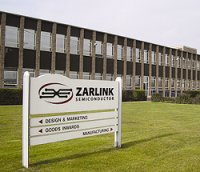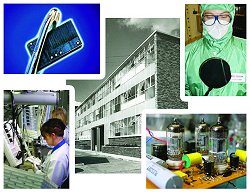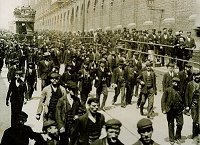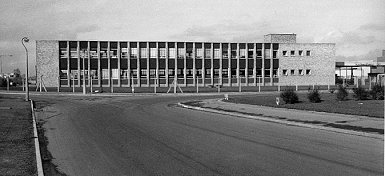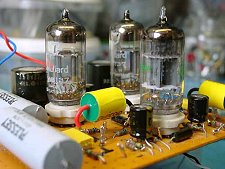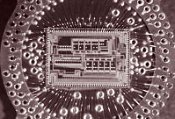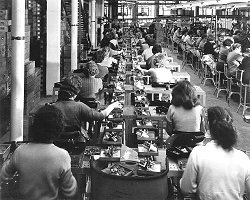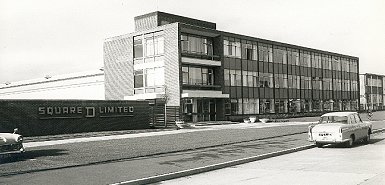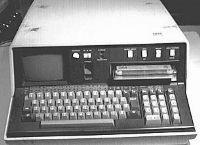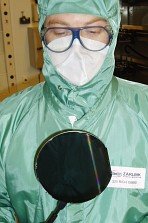|
|||||||||||||||
Sold for just 79p
Future uncertain for Zarlink Semiconducters
A pioneer in the post-war electronic age, Plessey (as the company was known for nearly 60 years) helped Swindon change from a town reliant on the railways and heavy engineering, to one that now boasts the headquarters of giants like Intel and Tyco.
An impact on Swindon's development that can only be measured in today's internet-dominated world.
We look back at its history...
The Electronic Age
The history of Plessey in Swindon
It was even a major reflector of shifts in the social history of the UK as a whole, and boasted what was possibly a unique 'claim to fame' in the 1960s. In fact, any local historian who has tackled the Plessey chapter in the town's history before now must have felt like the eminent historian who said the French Revolution was such a massive event that, 200 years later, it was 'too soon to tell' what its full impact on the world would be.
Swindon pre-Plessey
You need to look at a snapshot of Swindon before Plessey came to town to put into context the key role it was to play in the town's expansion and success after the Second World War.
And not only was it largely a one industry town. As far as employment was concerned, it was a one sex town too, because only 7.2 per cent of Swindon women worked - and most of them were on the payroll of clothing manufacturers J Compton and Sons.
The expansion of Swindon and the slow decline of the railways saw the town's fortunes undergo a rollercoaster ride in the 1920s and 1930s, with an Act of Parliament in 1928 necessary to extend a borough that was 'bursting at the seams'.
And crucially, by 1933 the town was at possibly its lowest ever ebb with 3,485 Swindonians out of work - mostly men.
But war changed everything - and by no means only for the worse.
New industries
Swindon's population leapt from 88,000 in 1939 to 104,000 in 1941 as new industries sprang up as part of the war effort, with Shorts, Vickers-Armstrong, Armstrong-Whitworth, Marine Mountings and, most importantly of all, Plessey, now providing employment for ex-railwaymen and a new batch of migrant workers.
Plessey, known then primarily as a manufacturer of radio components, opened its factory in Kembrey Street, Gorse Hill, in 1940.
Swindon was suddenly a place of opportunity as the new industries all expanded and, to their great credit, town councillors were already looking to the future, even before the war was over.
By 1952, when some items were still rationed, the Town Development Act had sealed Swindon's future, with Plessey playing a leading role.
The Act led to the building of Cheney Manor Trading Estate which was to become the heart of the ever expanding and diversifying Plessey operation as the company chose the estate as the site of its new factories.
The workforce had expanded to 2,300 by the mid-1950s, and by 1960 an incredible turnaround was complete, with Plessey supplanting the railway factory as Swindon's leading employer.
Its rival for the honour was, in fact, not the GWR but the Pressed Steel Fisher, but whereas the car body plant was as a direct result of Swindon's pedigree in heavy industry, Plessey was different.
The rapid transformation from a one industry town was complete because Plessey brought a brand of work to the area that had only previously been offered to such a large extent by Garrard (which Plessey would later own), providing employment in light engineering, electronics and component manufacture. But whereas Garrard was mostly restricted to manufacturing in one industry, Plessey's scope was far greater.
And it was part of a national phenomenon as well as a local one.
This wasn't immediately obvious to the consumer, but every radio and TV set required Plessey components to make them work because it mass-produced the small controls used to adjust the volume of almost everyone's radio and TV as well as TV brightness controls.
The town anonymously stamped its mark on a range of other household items too, with Plessey leading the industry at home and competing with the top firms in Europe in the provision of a wide range of components such as connectors, magnets and, as especially as technology advanced, electronic circuits.
Plessey components also found their way into other industries including guided weapons and the fledgling computer industry (or 'computors' as one press story called them).
At the birth of the silicon chip
A key role in the development of the new technology was the manufacture of semiconductor transistors, which were invented in the late 1940s.
And by 1957 Plessey decided it should have a stake in the new market and opened a new factory at Cheney Manor.
In the troubled 1970s, the Semiconductors division also provided a more optimistic outlook for Plessey in Swindon and now provides probably the loudest echo of the firm in the town, still occupying its original factory, though the Plessey name has long gone (Zarlink Semiconductor having acquired GEC-Plessey Semiconductors in 1998).
But if Plessey had a key role in the changing face of life in Britain and the rest of the world in the post-war period, its part in an employment revolution was just as important.
Though skilled male workers made up the majority of its workforce in the early days, the majority of Plessey's employees would eventually be semi-skilled women.
Working women
The company didn't pioneer female labour in the town because the 1930s had seen a rapid growth in the number of Swindon women who went to work.
Tobacco firm WD & HO Wills, clothing/uniform firm Compton's, raincoat manufactuers Nicholson's, the Cellular Clothing Company, Garrard and by then also the GWR all employed at least 200 women each in 1934 - but at least two thirds of these were unmarried girls.
The nature of the skilled male workforce was also different to other employers in the town because the diversity of its products meant Plessey offered a greater range of skills and opportunities.
Pressed Steel offered more pay, but apprenticeships at Plessey were reckoned to be better because of the variety of skills that were learned.
These usually lasted five years, with apprentices usually making their mind up about their chosen career path in the fifth year.
Some chose to work in the Resistors Division, which produced key components for electrical goods, while others went to the Connectors Division, which made heavy electrical units, including many used on aircraft and tanks.
The Preformations Division, producing permanent magnets, was another option, while others worked in the Hydraulics Division (later called Sundstrand) which turned out, among many other items, pumps for tractors and automatic gearboxes for double-decker buses.
Plessey's heyday
A brochure from a trade exhibition at the Polo Ground, Swindon, in September 1970 paints a fuller picture of Plessey in what could be considered its peak.
It also boasted:
'The Plessey Components Group is one of Europe's leading producers of electronics components and manufactures a wide range of products, including: resistors; potentiometers; connectors; wiring looms; magnets, micro-electronic circuts using the most advanced techniques; mechanical, electro-mechanical and sheet-metal assemblies; and the world-famous Garrard range of high quality sound reproduction equipment.'
Garrard's history is a story in itself and was an ultimately unhappy marriage, but the acquisition of the Swindon-based record player manufacturer was not the only local collaboration.
Square D, which also made a range of components from circuit breakers to 'complex controls for the complete automation of modern factories' (according to its own 1970 advertisement) began life inside one of Plessey's factories before emerging as a factory in its own right.
By the beginning of the 1960s the ranks of Plessey workers in Swindon had swelled to more than 5,000, but more expansion was to come with the opening of another Cheney Manor factory in 1962, providing a further 350 jobs in resistors. There were now three Cheney Manor sites - called Building 101, Building 102 and Building 103 - as well as the original and now substantial factory at Kembrey Street, which covered roughly the area of two football pitches.
Components for other major manufacturers were also among the units and parts that were turned out in their millions, with automatic lathes and other machines producing screws, bolts, bushes, rods, cogs, tubing, wheels and bars.
Plessey was also at the forefront of a new technology called sintered products which produced metallic components which couldn't be machined, by forcing powder into moulds under high pressure.
Each Plessey site was essentially a large factory, but also included other facilities such as offices, drawing offices, model shops, research and development areas.
But the firm's influence was felt beyond the confines of the factories.
The company encouraged sport - even to the extent of giving preference to good sportsmen when it came to job applications - and had a suitably impressive private sports ground in Ermin Street at Stratton St Margaret.
A social club in Gorse Hill was a popular venue for those who weren't necessarily so active.
For years after Plessey closed, the social club was called the ex-Plessey Club and was to be one of the most persistent reminders of its former glory after the firm's importance as an employer declined.
In the end, Plessey's leading role in the town was to be brief.
Change of name
Industrial relations problems in the 1970s and a hostile takeover by GEC in 1989 (though Plessey Semiconductors was still employing 800 in 1990 are probably more symptoms than causes, as the company, like just about every other British industry at the time, suffered from competition from abroad - especially the Japanese.
But despite all this, Plessey had left an indelible mark on Swindon.
It had not only paved the way for two radically different kinds of employment - an alternative to heavy industry and new opportunities for women.
In short, if you were turn the clock back a generation or two and lift the roof on Plessey's factories, you would find what looks like a blueprint for Swindon at the start of the 21st century.
Just as Plessey produced a rich variety of products and skills back then, so Swindon today enjoys a commercial variety that is the lifeblood of its continuing success.
And the genes that will probably shape its future owe more than a passing resemblance to Plessey's legacy.
Factfile and links:
It's ironic that the Second World War brought Plessey to Swindon because one of the company's founders was a German called Bill Heyme who helped set the company up in 1917, during the First World War.
Heyme was interned on the Isle of Man for a time but released on condition that he found a job 'of national importance'.
Working for a firm of woodworking machine manufacturers, he eventually found his way to the Clutsam Piano Action Company and was seen as one of the company's key assets when it underwent a management buy-out.
The new company took over Clutsam's machine shop in Marylebone where it produced jigs and tools, so Heyme surely fulfilled the conditions imposed on him when he was released from internment. Incidentally, there are no records to show that Plessey ever made pianos.
Heyme was still joint managing director when Plessey decided to open a new factory in Swindon in 1940.
The choice of Plessey as the company's name was mostly due to a bizarre coincidence.
The original firm had four shareholders - Bill Heyme, Thomas E Hurst-Hodgson and brothers Raymond Parker and Plessey Parker. Plessey also happened to be an area in Northumberland where Heyme's wife had grown up.
There were other, more practical reasons why Plessey seemed a good choice - and which seemed to be borne out as the company developed. It could be pronounced in any language but didn't reveal the nature of the business as its scope widened.
Another less scientific reason for choosing it was that the shareholders agreed the name simply had a pleasant ring to it.
Although Plessey was Swindon's leading employer for a period, its headquarters were never in the town.
The company was based in Ilford, Essex, but had large factories elsewhere, notably at Beeston, near Nottingham.
In fact, the company was so large, especially after it branched into the telephone industry and doubled in size overnight in 1961, that the Swindon operation - part of the Components Group and Dynamics Group - was only a relatively small part of the business overall.
Plessey's new factory was lucky to escape when Kembrey Street became one of the few roads in Swindon to suffer bomb damage during the Second World War. Five houses were hit on August 17, 1942 as a lone Dornier bomber killed 29 people.
The Plessey name still survives - along with the distinctive wave logo - in a South African company. It's the country's leading telecommunications company. |
|||||||||||||||
|
||||||||
|
||||||||
|
||||||||
|
||||||||
|
|||||||||





